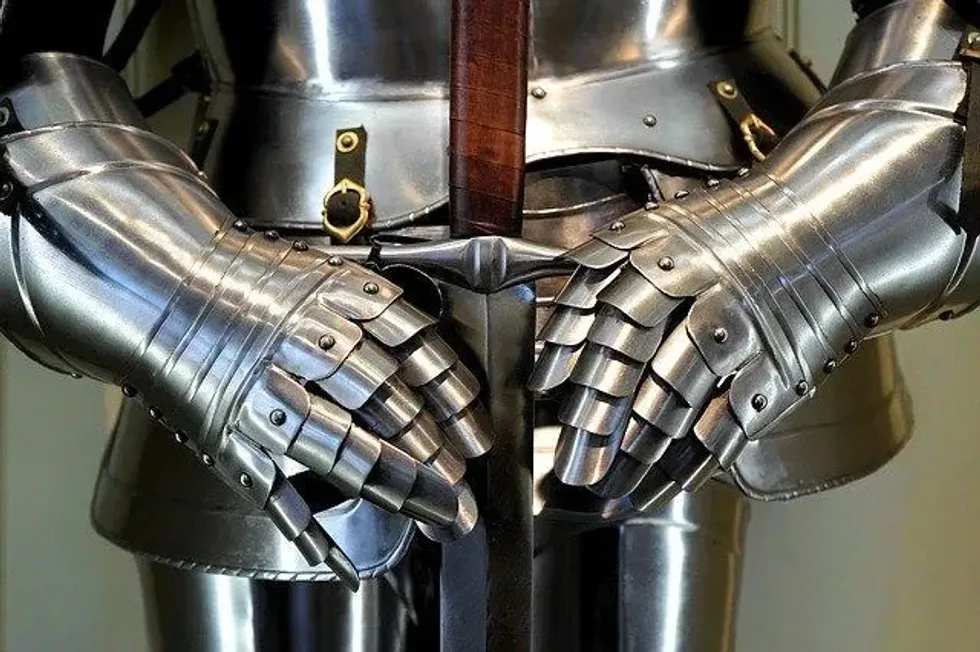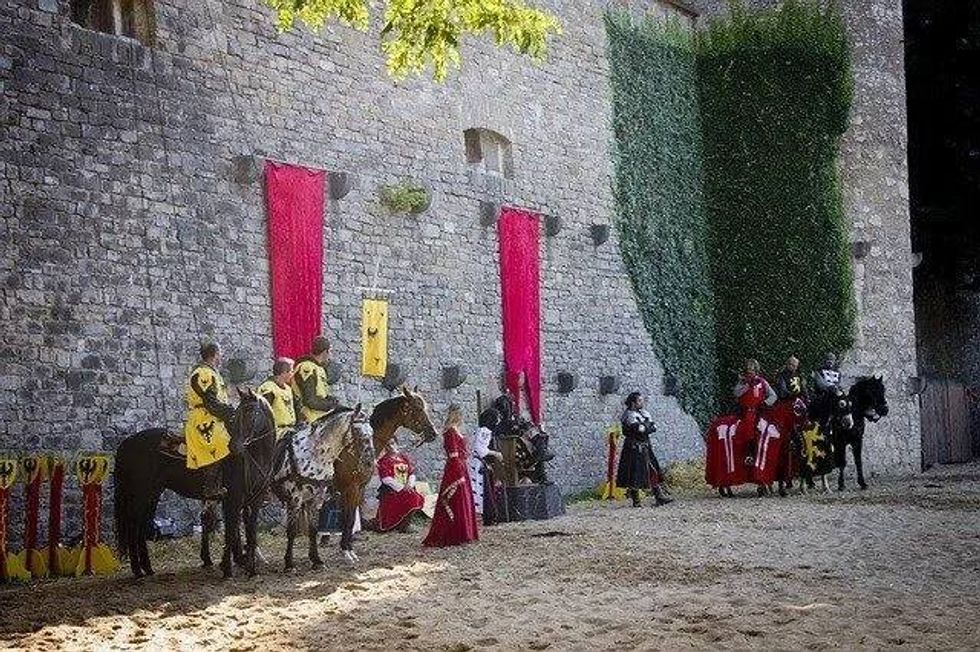How Strong Was Stone Age Armor? Get An Insight Into Their Defences

The Stone Age was a period that lasted for around 3.5 m years and came to an end when technologies related to metallurgy were discovered around 4000 and 2000 B.C.
During this period, stones were widely used for making tools and weapons with a sharp edge. While some basic form of metallurgy was known to humans during the Stone Age, the discovery of technologies related to the melting and smelting of copper signified the end of the Stone Age.
In the western regions of Asia, the Stone Age came to an end during the year 3000 B.C. It was during this time that bronze started being utilized widely and humans had created techniques for transforming copper alloys into highly efficient tools.
These tools replaced the usage of stone in various applications, effectively marking the end of the Stone Age.
Excavations across the world have revealed human remains with Stone Age tools belonging to the Stone Age era. Though tools prepared from animal bones have also been discovered they are not mentioned in contemporary archaeological records.
It is important to mention that the Stone Age has further been divided into different eras depending on the types of tools used. As a matter of fact, the Stone Age is one of the initial three important eras that have been identified in archaeology to define the transition of human civilization into an advanced species.
The Stone Age was subsequently followed by the Bronze Age and the Iron Age.
Have yiu enjoyed reading some basic facts about the Stone Age and the armor and weapons early humans used? If so, carry on reading to discover more about the history of the Stone Age, materials used, the benefits they brought to advancing humankind, and some amazing facts you may not know.
History Of The Stone Age
Do you wonder about the important historical aspects of the Stone Age? Here are some important facts related to the history of the Stone Age:
There were three main phases in the Stone Age:
The Paleolithic Period, often known as the Old Stone Age, lasted from 280 m B.C. to 10,000 B.C.
The Mesolithic Period, often known as the Middle Stone Age, lasted from 10,000 B.C. to 5,000 B.C.
The Neolithic Period, often known as the New Stone Age, lasted from 5,000 B.C to 3,000 B.C.
Before the invention of writing, Stone Age art reflects the first achievements in human inventiveness. While numerous artefacts from this period have survived, the understanding of ancient art and society is severely limited due to the lack of writer records.
The Paleolithic Or Old Stone Age: It traverses approximately 2.5 m years, from the starting of stone artifact-making to the end of the last Ice Age, around 9,600 B.C. This is defined as the longest phase of the Stone Age.
Stone Age culture was around long before the Bronze Age with bronze armor. People during the Stone Age had not yet made any major technocalogical advances, beyond the wheel, which was quite an achievement in itself.
It is rare to find specimens today.
But skeletons and stone tools, which show a progressive rise in sophistication, are the most common sorts of evidence.
There are numerous stone industries (also referred to as 'lithic' industries) based on the techniques used and the quality of the tools. Oldtown is the earliest of these (2.5 m years ago), and it consists of very primitive choppers and flakes.
Another type of lithic industry, known as Acheulean, emerged around 1.7 m years ago, generating more sophisticated and symmetrical shapes with sharp edges. There are various other types of lithic industries until we find a 'revolution' of lithic industries near the end of the Paleolithic period, around 40,000 years ago, in which several different types coexisted and evolved swiftly.
We also have the first recorded expressions of artistic life around this time: personal decorations, cave paintings, and mobile art.
The Mesolithic Age: It is also known as the Middle Stone Age, beginning at 9,600 BC, at the end of a period known in geology as the Younger Dryas stadial, the last cold snap that marked the end of the Ice Age. When agriculture begins, the Mesolithic period came to an end. This is when the late hunter-gatherers lived.
There is no one date for the end of the Mesolithic period because agriculture emerged at different times in different parts of the world. Agriculture evolved at different times even within a single location. Agriculture, for example, began around 7,000 B.C. in south-east Europe, 5,500 B.C.
in central Europe, and 4,000 B.C. in northern Europe. All of these elements make the Mesolithic chronological borders a little hazy. Furthermore, some areas do not have a Mesolithic epoch.
Our globe underwent significant large-scale changes throughout the Mesolithic epoch. As the temperature warmed and ice sheets melted, land in the northern hemisphere rose as they were liberated from the ice's weight.
At the same time, sea levels rose, drowning low-lying areas and causing major land changes around the world: the Bering Strait was flooded, separating the Japanese islands from the Asian mainland, Tasmania from Australia, the British Isles from continental Europe, East Asia, and North America, and Sumatra was separated from Malaysia with the formation of the Strait of Malacca.
The shape of the continents and islands around 5,000 B.C. was fairly similar to what they are now.
The Neolithic Or New Stone Age: It begins with the advent of agriculture, which may be traced back to around 9,000 B.C. in the near east, 7,000 BC in south-east Europe, 6,000 B.C. in East Asia and, later on, in other parts of the globe. Cultivation of cereals and animal domestication began around this time.
Forest clearance, root-crop cultivation, and cereal cultivation were all brought about by agriculture, which changed the way human civilization is organized and how it uses the land that can be preserved for a long time, as well as the advancement of herding technology and new farming techniques like irrigation systems, ploughs, and so on.
More intensive agriculture means more food for more people, more villages, and a shift towards a more complicated social and political structure.
Villages gradually evolve into towns, and then into cities, as the population density of the villages grow.
Copper metallurgy was introduced around the end of the Neolithic era, marking the start of the Bronze Age, also known as the Chalcolithic or Eneolithic era, where metal weaponry was cast.
Materials Of The Stone Age
Organic materials, such as antler, bone, fiber, leather, flint, and wood, were also used to make tools and weapons throughout the Stone Age, along with stone.
The archeological record, on the other hand, favors artifacts constructed of stone because they are significantly more enduring than organic materials, which are readily wiped out by the multiple processes of decay to which they are subject and can only survive in extreme conditions such as extreme cold or extreme dryness.
Copper- and glass-made products, among other robust materials, have also survived. Plant, animal, and human remnants have also managed to survive under unusual circumstances, sometimes simply petrified, but other times still containing soft tissue, such as the many frozen specimens of the extinct wooly rhino and wooly mammoth that have survived almost intact in Siberia.
Clay is another ubiquitous substance found in the majority of Stone Age relics. Clay may be shaped into whatever shape you like and then baked to keep its shape. This is the start of the ceramic industry. Because usable clay is widely available, pottery was invented independently in several places of the world at different eras.
The oldest evidence of pottery production has been discovered in Japan's Odai Yamamoto archeological site, where fragments from a single vessel have been dated to 16,500 B.P. to 14,920 B.P. (before present). By around 13,000 B.P., non-agricultural Jomon peoples in Japan were creating intricately designed clay pots that were used for food preparation.
Special ovens were developed in the Near East during the Early Neolithic era, circa 8,000 B.C., to parch cereal grains and bake bread, allowing people to manage fire and produce high temperatures in confined facilities. Initially, pottery was created over an open fire, but the advent of ovens expanded the range of options.
Some parts of South America were developing pottery technologies at the same period.
Weaponry was very important throughout every point in history for centuries. Early humans made short swords of wood and a simple bow for weaponry.
They had wooden bows, flint daggers, carved flint knives, and wooden arrows. They used their wooden bows and arrows, and flint daggers in battle. A carved flint would be attached to a wooden shaft, to make a short sword or dagger.
Combat required them to be strong and efficient to ensure protection. Combat was a way to assert dominance and power over other groups.
A bow is a weapon of power used for shooting. A bow was one of the earliest formed weapons. Spears followed, and these gave early humans the power and force for hunting, and spears helped in fights as well.
The Stone Age came to an end with the invention of bronze metallurgy. Bronze is a copper-tin alloy with better hardness and durability, superior casting characteristics, and a lower melting point than copper.
Bronze could be utilized to make weapons, which was not possible with copper because it was not tough enough to withstand fighting conditions. Bronze eventually replaced stone as the principal material for tools and weapons, rendering much of stone technology obsolete and announcing the end of the Stone Age.
Steel was a real breakthrough in the arms race, when steel axes and steel swords could be forged as weapons and were used in battle, especially in Western Europe. Steel blades were forged in fire and attached to wooden shafts replacing the former flints. Steel swords and axes were very powerful weapons.
As technology improved, people also started replacing leather armour, made of sewn animal skins, with metal, in the Iron Age. They would make chainmail armour and helmets, spears and swords, which made war more deadly.

Benefits Of Stone Age Armor
The Paleolithic Age was the first period in which human activity was documented. People were strictly hunter-gatherers throughout this historical period. Hunter-gatherers lived during the Early Stone Age and foraged wild plants and animals for nourishment.
Early people invented helmets to protect their heads during combat. The head, being one of the most sensitive places, needed extra care, and the helmets provided that care to the head.
Helmets made sure that the head did not break in one blow of the sword, and hence helmets were used extensively in battle. They could also be made to look fearsome in appearance.
Early people would sew animal skins and make armor to cover their bodies. This 'armor' would withstand a wooden blade and minor animal bites.
A wooden spear or an axe would be carved from a branch to kill animals and the leather armor would help resist the sharpened point, though no doubt it would still pierce tough leather.
Because no government or rules had yet been established, the Paleolithic people lived in an egalitarian society. This allowed everyone to be treated equally and to have the same rights as everyone else.
Individuals were able to maintain a sense of kinship that allowed them to live with people who shared their ancestors, with a reliance on the family group and extended family.
Next, because they were collecting their food directly from the environment, hunter-gatherers tended to have a healthier diet. Plants were plentiful, but animals (meat) were not always available.
This contributed to the hunter-gatherers' second advantage: living more sustainably. This means that inhabitants of this era attempted to maintain their environment by only using its resources when necessary. The importance of environmental preservation could not be overstated for the people of the Stone Age era as all their activities were performed while keeping in mind the environment.
Amazing Facts About Stone Age Armor
In the 1940s, an Australian archeologist named Gordon Childe popularized the term Neolithic Revolution to highlight the profound impact that agriculture had on the human population.
It is now thought that the impact of agricultural innovation was exaggerated in the past and that the evolution of Neolithic society was more gradual than a rapid change.
Skara Brae in Scotland has some of the best surviving Stone Age homes. After a storm in 1850, the Stone Age settlement was unearthed. Researchers discovered a 5000-year-old Neolithic town that had been well maintained. Many of the rooms included custom-made furniture, such as dressers and beds. Dice, tools, ceramics, armor, and jewelry, among other things, were discovered.
Because there were no processed or sugary foods in the Stone Age diet, many people feel it was far healthier than the one we have today. The 'Paleo' diet has recently gained popularity, and it is based on the food of our Paleolithic forefathers!
Bones, wood, and vegetable fibers would have been shaped as tools, like axes, swords, and spears, before the Stone Age. Learning to use stones as tools and weapons instead of wood was a significant step forward for humans.
We Want Your Photos!
More for You
Bachelor of Science specializing in Human Anatomy

Joan AgieBachelor of Science specializing in Human Anatomy
With 3+ years of research and content writing experience across several niches, especially on education, technology, and business topics. Joan holds a Bachelor’s degree in Human Anatomy from the Federal University of Technology, Akure, Nigeria, and has worked as a researcher and writer for organizations across Nigeria, the US, the UK, and Germany. Joan enjoys meditation, watching movies, and learning new languages in her free time.
Disclaimer
1) Kidadl is independent and to make our service free to you the reader we are supported by advertising. We hope you love our recommendations for products and services! What we suggest is selected independently by the Kidadl team. If you purchase using the Buy Now button we may earn a small commission. This does not influence our choices. Prices are correct and items are available at the time the article was published but we cannot guarantee that on the time of reading. Please note that Kidadl is a participant in the Amazon Services LLC Associates Program, an affiliate advertising program designed to provide a means for sites to earn advertising fees by advertising and linking to Amazon. We also link to other websites, but are not responsible for their content.
2) At Kidadl, we strive to recommend the very best activities and events. We will always aim to give you accurate information at the date of publication - however, information does change, so it’s important you do your own research, double-check and make the decision that is right for your family. We recognise that not all activities and ideas are appropriate for all children and families or in all circumstances. Our recommended activities are based on age but these are a guide. We recommend that these ideas are used as inspiration, that ideas are undertaken with appropriate adult supervision, and that each adult uses their own discretion and knowledge of their children to consider the safety and suitability. Kidadl cannot accept liability for the execution of these ideas, and parental supervision is advised at all times, as safety is paramount. Anyone using the information provided by Kidadl does so at their own risk and we can not accept liability if things go wrong.
3) Because we are an educational resource, we have quotes and facts about a range of historical and modern figures. We do not endorse the actions of or rhetoric of all the people included in these collections, but we think they are important for growing minds to learn about under the guidance of parents or guardians.







